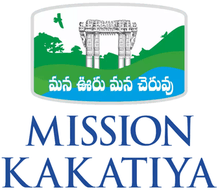Mission Kakatiya
| Mission Kakatiya (మన ఊరు మన చెరువు) | |
|---|---|
 | |
| Type of project | Restoration of 46,000 Tanks and Lakes |
| Location | Telangana, India |
| Founder | Government of Telangana |
| Chief Minister | K. Chandrashekhar Rao |
| Ministry | Ministry of Irrigation |
| Established | 12 March 2015 |
| Status | Active |
| Website | Official website |
Mission Kakatiya (మన ఊరు మన చెరువు) is a programme for restoring all the minor irrigation tanks and lakes in Telangana State, India. The programme helps in rejuvenating 46,531 tanks and lakes, storing 265 TMC water across the state in five years.[1] This is the first program to be taken up by the Government of Telangana after coming into power in June 2014.
The tanks and lakes are dug to remove silt for increasing water storage capacity. The household agricultural income has also increased 78.50% in the tank ayacut area.
History
The agriculture was solely depended on the tanks. Until the Nizam rule, the tanks had a capacity of 244 TMC in Telangana region, but due to negligence most of it was lost. The irrigated land (ayacut) under 70,000 tanks in 1956 was around 25 lakh acres. By 2014 the tanks left were 46,531, nearly half of them were dry. The farmers started depending on water wells for agriculture. When the water table depleted the wells dried up, farmers started digging borewells, which also dried up for lack of ground water.
The program was inaugurated on 12 March 2015 by the Chief Minister of Telangana, K. Chandrashekar Rao, his brainchild, at Patha Cheruvu in Sadashiva Nagar in Nizamabad district. It is expected to be completed by end of 2018.[2] The name 'Mission Kakatiya' is a tribute to the Kakatiya rulers, who developed a large number of the chain tanks across Telangana for agriculture. The project is taken up by Minister of Irrigation, T. Harish Rao.
The Project
The project was taken up in four phases:
- Phase 1 - 8003 tanks
- Phase 2 - 8927 tanks
- Phase 3 - 5886 tanks
- Phase 4 - 6000 tanks
- Phase 5 - Remainder and New tanks creation
Big tanks and lakes, with higher ayacut, were taken up first. By March 2018, 27,713 lakes work was completed, spending ₹8700 crores, stabilizing and providing water for 20 lakh acres.
Usage of Silt
The usage of silt or soil that is rich in soil nutrients was transferred by the farmers to their fields. Nearly 7 Crore tractor silt dug up from the tanks was used by the farmers.
The crop yield proved to be a boon, as published by pioneering, patented work of a Telangana farmer, Chintala Venkat Reddy. The yield for cotton had gone up by 11.6%, maize by 6.7% and paddy by 4.4%. And the fisherman’s income went up by 30-35%.
Success
By using surface water instead of bore well water there was a marked change in quality. Over 2.88 lakh acres of new ayacut was stabilised and will reach 12 lakh acres by the completion of the project. The ground water table increased from 6.9% to 9.2%. The livelihood of fisherman community was also restored.
The water activist, popularly known as Waterman of India, Rajendra Singh, toured the rejuvenated lakes and was impressed by the turnaround of life. He celebrated his birthday in 2016 on a lake bund in Warangal.
Geospatial database
The geotagging and geospatial database is maintained for 45,800 tanks, for analysis and monitoring.[3] Every tank is assigned a unique GEOID, based on its latitude and longitude. This help the engineers to plan and monitor effectively with an exhaustive, granular and realtime data, obviating the need for manual recording. The sanitization of the tank database is done by Command Area Development Authority (CADA). This is helping the Department to estimate the area of irrigated land, crops under a given tank, for each season using satellite imagery like Google Earth.
Biodiversity
The project has resulted in return of many migratory birds because of water levels and fishes in the tanks.
Studies
The project is being studied different government agencies, and also two US based universities, University of Michigan and University of Chicago.[4][5]
University of Michigan
University of Michigan study group are developing a low-cost way to increase crop yield and reduce the use of fertilizers for Indian farmers. A multi-disciplinary team of 16 students, from eight schools of the university, after having analysed the work in two villages of Adilabad and Karimnagar districts for 12 months to learn about the program’s effectiveness.[6] Their findings include reduction of fertilizer usage, reduced power utilization, increase in crop yield. [7]
University of Chicago
University of Chicago’s Tata Development Centre has come forward to do a detailed 2-year study of the program, which will evaluate its impact on agricultural, environmental and economic outcome.
NABCON
Government of Telangana requested NABARD’s affiliate, NABCONS to do a study. The findings in Impact Assessment Report, was carried out in late 2017 on phase 1 part, found that the ayacut increased over 51% after the project, 17% dried up wells and borewells sae water coming back, decrease in utilization of fertilizers, significant increase in groundwater table, and 39% increase in fishing.
IRMA
Institute of Rural Management Anand also did a study on the effectiveness of the project.
Telangana Agriculture University
Prof. Jayashankar Telangana State Agricultural University is also doing a study.
References
- ↑ "Mission of the program - Mission Kakatiya". missionkakatiya.cgg.gov.in. Retrieved 2018-01-19.
- ↑ "Mission Kakatiya to be launched today". Deccan Chronicle. 2015-03-12. Retrieved 2018-01-19.
- ↑ https://telanganatoday.com/central-team-to-recommend-mission-kakatiya-in-other-states
- ↑ ‘Mission Kakatiya already showing positive results’ - The Hindu
- ↑ Mission Kakatiya wows US varsities
- ↑ Desilting ponds in India benefit farmers, environment | University of Michigan News
- ↑ U.S. varsity students’ study on Mission Kakatiya vies for NatGeo award, The Hindu, 2017-09-15